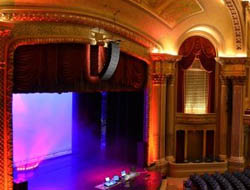
System installation
Once the system was designed, it was primarily up to Kang and his Custom Audio team to get it up and running. “The first part of my job was to analyze all aspects of the installation and the logistics of the project,” Kang says. “We figured out what parts of the existing system could be re-used and what needed to be removed. Custom input panels and floor mounts for some of the front-fills needed to be designed and manufactured. Laser-engraved name tags needed to be laid out for etching. Rigging hardware needed to be sorted out and ordered. Speakers needed to be disassembled and painted. And I had to decide what would be the most efficient use of the NetMax processing power – what was both practical and useful for the theater to have – so that I could program an initial IRIS-Net file for the controller.”
After these preliminaries came the installation itself. “We tackled the loudspeakers first,” Kang says. “The EVF-1181S subs were fit into the existing bunkers with fractions of an inch to spare. Then came the six Xi-1082s for under-balcony, which were painted to match the ceiling color. The locations were spiked to within inches of the designed placement and approved by the theater before mounting. The four Xi-1082 front-fills were simply placed, but custom speaker cable was built to allow the orchestra pit to move freely behind them. The QRX subs in front of the proscenium arch also needed custom speaker cable to allow the fire curtain to close without obstruction. The final part was to hang the XLD281 array on an existing frame suspended from a permanent hoist. We gained an additional foot of clearance for sightlines by re-engineering the existing frame and tucking the XLD grid right up to it.”
On the electronics side, Kang says, “the first order of business was to remove all the old equipment from the racks without damaging or disrupting the existing patchbay or wiring. We had to patch around an existing patchbay designed for analog EQs and crossovers and incorporate the NetMax controller while still leaving most of the patchbay 100% functional. This was not an easy task, as most of the wires in the back of the rack were not labeled correctly or had been changed over the years. Then we loaded the new amplifiers into the existing amp rack, and remoted one additional amplifier to another nearby rack. The final test was to pass noise to all of the components and verify that everything was wired correctly.”
All in all, Kang says, “the system was well designed and has excellent coverage. The XLD281 is a great-sounding full-range box, very intelligible with a very smooth midrange, and not a lot of hassle either to rig or to EQ. Having made a couple of pre-site visits, there were not a lot of unforeseen issues during the install itself.”
In addition to the main loudspeaker system, Custom also installed various ancillary audio systems, including a Bosch Integrus wireless infrared language distribution system with a four-channel NT-TX transmitter, 24 pocket receivers, and two medium-power radiators capable of transmitting 20H to 20K audio. The Integrus, which is rackmounted in the sound booth, is used as an assistive listening system for ADA-compliance as well as to transmit surround sound to remote speakers.
For wireless, Custom installed a four-channel Electro-Voice REV system composed of REV-D dual receivers and REV-WTs bodypack transmitters. “The RE-V wireless is a professional-level system that has tour-grade durability and also the sonic quality that a lot of today’s artists and engineers demand,” Kang says.
Four new REV-HD767s, which combine an REV-H handheld transmitter with an N/D767a microphone head, were purchased for use with the wireless system, as were four RE97 lavalier microphones. “The N/D767a is a great-sounding capsule,” Kang says, “and the REV-H is durable and also compatible with Shure capsules. As for the RE97LTx lavaliers, they are great-sounding microphones not just for speech but for performance as well.”
A happy ending
With the system installed, Custom and Quantum commissioned the room, comparing actual performance to the response predicted by EASE modeling. “We had done a very extensive EASE analysis before we put that rig in the room,” Brown says. “The system performed as expected; the coverage was what EASE had said it would be. The delays voiced well to the mains, and after we time-aligned the subs and Smaarted the room we did about five presets, and they all sounded very, very good: high intelligibility, nice smooth coverage, good balance. It was interesting to hear how well the line array performed as a single point source, maybe better than we could have pulled off with stacked three-wide horizontal arrays. We have way more control with the line array.”
Pleased with the results, Tallman, Brown, and Kang demonstrated the system’s capabilities for the local live sound community. “We not only trained the theater’s own techs, we also invited all of the local techs so they would know what they had when they walked in the room,” Brown recalls. “And we also made some slight adjustments based on their input, so we involved everybody.”
“You could tell that the locals engineers were thinking that the room hadn’t sounded that good in a long, long time,” Tallman adds. “So I was happy, Custom Audio was happy, and more than anything, the theater management was very happy, with smiling faces all around. We knew that everyone—the owner, the facility manager, the front-of-house guys, the production managers, and the audience—each has their needs, and we wanted to make all of them happy. That’s exactly what we achieved with this system.”
